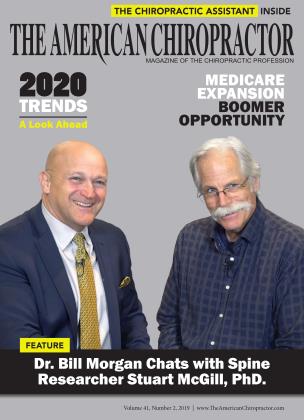How Visceral Dysfunctions Cause Structural Symptoms: Stress, Symptoms, and Energy Deficiency
STRESS
By Howard F. Loomis, Jr., DC
One of the most perplexing challenges facing chiropractors today, especially those relatively new to practice, is knowing how to determine the cause of the patient's symptoms and knowing how to explain that clearly and with confidence to the patient. I guess, in that regard, not much has changed since I started practice in the late 1960s. This month, I am starting a new series of monthly articles that will attempt to relieve some of that frustration.
So, let’s start with this: The American Medical Association has noted that stress goes unnoticed as the basic cause of more than 60% of all human illness and disease. In fact, they consider it to be behind the initiation, exacerbation, and maintenance of most killer diseases, such as heart disease, hypertension, diabetes, cancer, and mental illnesses.
Explaining that to patients should be quite easy because they believe all stress is mental or emotionally induced. Not true. The human body is required (with no exceptions) to constantly do the following three things:
• Structurally oppose gravity
• Physiologically maintain homeostasis within the extracellular fluids
• Maintain emotional and cognitive stability
There you go, only three causes for symptoms, and it gets easier because all three functions require energy. Yes, all symptoms are caused by energy deficiency of specific organs or tissues when they are no longer able to fulfill their responsibilities. There are only two sources of stored energy in the body; both the liver and the muscles store glycogen to be used when needed. The liver can convert stored glycogen to glucose as needed to elevate glucose levels for distribution to the brain and organs. Unfortunately, the largest source of stored glycogen is in the muscles, and they don’t share.
So, let’s quickly recap: We can put our patient’s symptoms into one of three boxes: structural, visceral, or emotional. They are all caused by energy deficiency that has been brought on by stress. Finally, amazingly, the body has a specific physiological cascade of events to meet energy demands for increased need, regardless of the cause.
The Physiological Stress Cascade
We know well the body’s “fight-or-flight” response for acute emergencies, but often don’t realize the same process is in effect to counter chronic or long-standing stress in our lives. When the brain recognizes it lacks adequate glucose to meet its energy demands, it strongly stimulates both the sympathetic nervous system and the endocrine system to elevate available glucose levels. Those organs and tissues that are being stimulated to respond can become exhausted. Just because the CNS sends the instruction doesn’t mean the organ can respond appropriately.
Let’s examine that stress cascade and see if it applies to any patients you see.
Immediate Systemic Changes:
• Increased arterial blood pressure. How many of your patients have high blood pressure? Do you check a patient’s blood pressure on every visit?
• Increased rates of cellular metabolism throughout the body. How many of your patients are on thyroid medications?
• Increased mental activity. How many of your patients have difficulty sleeping or struggle relaxing and becoming serene? Which of your patients routinely use “sleeping pills”?
• Increased blood clotting. How many are on so-called “blood thinners” or take a baby aspirin every day?
Immediate Musculoskeletal System Changes:
• Increased blood flow to active muscles.
• Increased glycolysis in muscle tissue, resulting in increased muscle strength.
Immediate Visceral Organ System Changes:
• Decreased blood flow to organs that are not needed for rapid activity. Which systems would those be?
• Decreased digestive secretions and peristalsis. How
many patients have digestive and/or bowel elimination problems?
• The cells send their amino acids to the liver for conversion to glucose. How many of your patients are protein deficient? Are you familiar with the symptoms of a protein deficiency?
Other Symptom Patterns
The body won’t continue to indefinitely remove cellular amino acids, which it needs for growth or repair of tissues. It will move to the next available source, which is stored fat. That will bring on problems of its own. While the ketogenic diet is much in vogue, it is also the body’s last refuge for energy.
What symptoms will your fashionable patients suffer from its use? We’ll deal with those issues later in the series.
For now, I would like to end by stating my intention is to review each of the ten organ systems regarding the effect of stress, the resulting visceral symptoms, and related structural relationships.
It is my intention to present the neurological, visceral, and structural connections established during the first 12 weeks of embryonic development. In that way, I can give assurance that chiropractors have always been able to identify the cause of nonpathological and infectious symptom patterns, and bring relief where others fail. This is even more true today than it has ever been due to the advances in available information.
HowardF. Loomis, Jr., DC, has an extensive background in enzymes and enzyme supplements. He is the founder and president of the Food Enzyme Institute. His extensive knowledge of physiology, biochemistry, and enzymology has made him a sought-after speaker and a prolific writer. The Food Enzyme Institute offers seminars to healthcare practitioners around the country.
Dr. Loomis published ENZYMES: The Key to Health in 1999. He also co-authored and published The Enzyme Advantage: For Healthcare Providers and People Who Care About Their Health in 2015, and The Enzyme Advantage for Women in 2016, with respected medical journalist Arnold Mann.
Contact info: 478 Commerce Dr. Suite 201, Madison, WI 53 719. [email protected], 800-6622630.
 View Full Issue
View Full Issue









